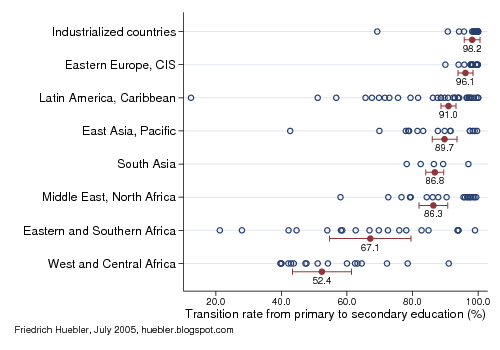The following graph shows the transition rate from primary to secondary education for 147 countries for which the Global Education Digest 2005 has data. The blue circles indicate the transition rate in each country. The red marks indicate the average transition rate in each region and the 95% confidence interval for this average.
Transition rate from primary to secondary education, 2002/03

Data source: UNESCO Institute for Statistics (UIS). 2005. Global Education Digest 2005. Montreal: UIS.
Note: Regional averages are weighted by each country's population of primary school age.
Worldwide, 85% of children in the last grade of primary school go on to attend secondary school (see the table below). Only two regions have transition rates below this global average: Eastern and Southern Africa (67.1%), and West and Central Africa (52.4%). Transition rates are highest in the industrialized countries (98.2%) and in Eastern Europe and the CIS countries (96.1%). However, even in Sub-Saharan Africa some countries have transition rates above 80%.
Transition rate from primary to secondary education, 2002/03
| Region | Transition rate (%) | ||
| Male | Female | Total | |
| East Asia, Pacific | 89.8 | 89.7 | 89.7 |
| Eastern and Southern Africa | 67.4 | 66.6 | 67.1 |
| Eastern Europe, CIS | 98.8 | 98.7 | 96.1 |
| Industrialized countries | 98.1 | 98.1 | 98.2 |
| Latin America, Caribbean | 92.0 | 91.3 | 91.0 |
| Middle East, North Africa | 86.4 | 86.1 | 86.3 |
| South Asia | 84.5 | 89.5 | 86.8 |
| West and Central Africa | 54.6 | 49.4 | 52.4 |
| World | 84.4 | 85.4 | 85.1 |
Note: Regional values are weighted by each country's population of primary school age.
The difference between male and female transition rates is negligible, except for two regions: South Asia, and West and Central Africa. In South Asia, girls are more likely to transfer to secondary school; the transition rate is 89.5% for girls and 84.5% for boys. In West and Central Africa, the opposite can be observed; here the transition rate is 54.6% for boys and 49.4% for girls. Girls in this region are thus doubly disadvantaged. Not only do they have very low primary school enrollment rates, they are also less likely to continue their education at the secondary level.
Friedrich Huebler, 17 July 2005, Creative Commons License
No comments:
Post a Comment